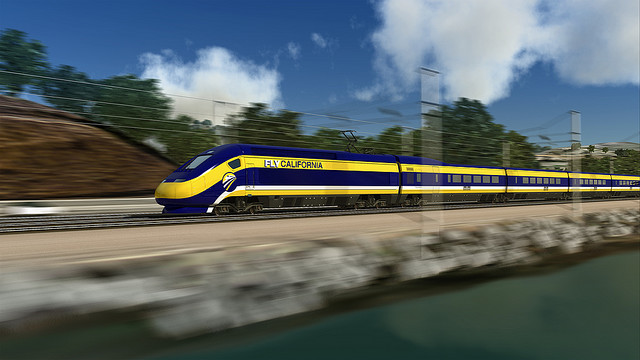Happening Now
Hotline #839
November 29, 2013
Due to the Thanksgiving Holiday, NARP will be presenting an abridged version of the Hotline this week.
Have a wonderful Thanksgiving, and safe travels!
-The NARP Staff
News in Brief

—NARP is reconfirming its support for the construction of a high-speed rail line between San Francisco and Los Angeles in the wake of a court ruling handed down by a Sacramento Superior Court Judge.
Monday’s ruling by Sacramento County Superior Court Judge Michael Kenny said that the California High Speed Rail Authority (CAHSRA) cannot issue a blanket validation for more than $8 billion in bonds approved by California’s voters in 2008.
However, Judge Kenny rejected opponents’ request to stop construction on the 220 mph rail corridor that will connect Northern and Southern California; work will move ahead in 2014 as planned using federal grants. CAHSRA has already begun reworking the project’s financial plan, and will continue to work with the State Treasurers office to issue the bonds through other channels.
“I’m disappointed that the courts have decided to apply financial standards that highways and airports would never have to meet,” said NARP President Ross Capon. “However, I have every confidence that Governor Brown and the Authority will respond to these challenges by strengthening the plan. We are also calling on federal authorities to renew support of this key legacy infrastructure project, and develop an affordable investment framework to guarantee the line's completion and meet the requirements of the Superior Court judge's order.”
The need for the rail service is not in question—California's increasing population and the needs for its citizens to move around the state in an efficient manner remain undiminished. Numerous studies have confirmed that additional runways and freeway lanes would cost more than high speed rail—an estimated $171 billion to provide an equivalent capacity through an additional 2,300 lane-miles of highways, 4 runways, and 115 airline gates. Additionally, these alternatives would not bring the benefits of high speed rail, which reduces harmful emissions, allows for the efficient movement of people through densely developed corridors, and leads to economic development in downtowns and around stations.
—The Commonwealth of Pennsylvania passed a $2.3 billion transportation budget this week. The majority of the money will be directed at highways. However, rail operations in Philadelphia, Pittsburgh, and on Amtrkak’s Keystone Corridorwill also receive funding in the package. The greater Philadelphian metropolitan region’s transit system, SEPTA, will receive $340 million per year.
—The Missouri Department of Transportation opened a new $28 million, 1,200-foot railroad bridge across the Osage River, adding capacity and improving on-time performance for Amtrak’s Missouri River Runner trains (Kansas City – St. Louis) and freight trains.
—Amtrak’s New Orleans-to-New York Crescent derailed in South Carolina early Monday. Seven of the nine cars left the rails, but all stayed upright. None of the 218 people aboard (211 passengers, 7 crew) were seriously injured. Four passengers were sent to the hospital as a precaution but were not admitted. Amtrak, Norfolk Southern and the Federal Railroad Administration are investigating the cause of the derailment; the extreme cold is suspected to be a contributing element.
—Louisiana’s St. John the Baptist Parish Council unanimously voted to join the Louisiana Intrastate Rail Compact, becoming part of the movement to develop passenger rail service between New Orleans and Baton Rouge.
—The New Jersey State Assembly’s Committee on Transportation, Public Works and Independent Authorities voted to approve a resolution supporting the expansion of New York City’s Number 7 subway line into Hoboken, New Jersey.
—The Wisconsin Department of Transportation is teaming up with Amtrak to install Wi-Fi on the Hiawatha service(Milwaukee – Chicago).
—The University of Texas at Arlington released a study that identified highway rights-of-way as the most economical corridors to build high-speed rail in Texas, and recommended four routes for additional study.
From the NARP Blog
—Pay no attention to the tax-sucking behemoths behind the curtain: As might be expected, last week’s kangaroo court-style hearing into Amtrak’s food and beverage service has caused critics of the railroad to emerge from the woodwork. These critics have rehashed tired claims against passenger rail in the United States, arguing that it’s a money-losing proposition that has no real future. [Read More]
—Spinning the budget, kicking the can down the road while the roads (and Amtrak) deteriorate: Amtrak figured in a rather positive way in a November 21 Washington Post editorial, “Where the money is: As Congress faces yet another spending deadline, it continues to ignore the true debt problem.” The Post was ridiculing suggestions about what would constitute meaningful budget savings. Here’s the key passage: The Congressional Budget Office’s latest report on deficit-reduction says “Congress and the president must resolve to tackle programs and tax breaks that benefit middle- and upper-middle-class America. That’s not what you generally hear from Republicans, who emphasize savings from, say, eliminating Amtrak subsidies (a mere $15 billion item over 10 years, according to the CBO report) or tightening food stamp eligibility ($50 billion).” The editorial goes on to chastise Democrats for putting too much faith in eliminating such things as “tax preferences for oil drilling and the like ($34 billion).” [Read More]
—Trains are selling out for Thanksgiving, without the media’s help: As we again enter the year’s busiest week of travel, the focus of the mainstream media returns to congestion on the roads and in the skies. Trains are occasionally included in the picture, particularly on the Northeast Corridor. And indeed we spent a good 20 minutes on the phone this morning with an AP reporter interested in tips for people using crowded trains this holiday weekend. [Read More]
"Saving the Pennsylvanian (New York-Pittsburgh train) was a local effort but it was tremendously useful to have a national organization [NARP] to call upon for information and support. It was the combination of the local and national groups that made this happen."
Michael Alexander, NARP Council Member
April 6, 2013, at the Harrisburg PA membership meeting of NARP
Comments